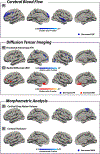Hypertensive disorders of pregnancy and neuroimaging markers of dementia risk: A pilot study
- PMID: 40881303
- PMCID: PMC12383491
- DOI: 10.1002/pmf2.70020
Hypertensive disorders of pregnancy and neuroimaging markers of dementia risk: A pilot study
Abstract
Background and objectives: Hypertensive disorders of pregnancy (HDP) are associated with a long-term risk of maternal cognitive decline. Limited data exist regarding maternal brain structure in midlife after HDP. We examined the association between prior HDP and neuroimaging markers associated with microvascular brain injury, detected on high-resolution brain MRI.
Methods: We conducted a pilot study embedded within the nuMoM2b Heart Health Study, a multicenter prospective cohort of nulliparous US individuals recruited between 2010 and 2013 in the first trimester of pregnancy. Participants with no history of HDP, preterm birth, small-for-gestational age infant, or stillbirth in any pregnancy, and participants with HDP in the index or any subsequent pregnancy were invited to undergo brain MRI at two study sites between December 21, 2021 and September 30, 2023, using a standardized protocol on identical scanners. Imaging outcomes of interest included white matter hyperintensity (WMH) volume, regional cerebral blood flow (CBF), fractional anisotropy (FA), radial diffusivity (RD), regional grey matter volume (GMV), and cortical thinning.
Results: A total of 81 participants (mean age 39 years; 27% White, 9% non-Hispanic Black, 52% Hispanic, 10% Asian) had brain MRI, of whom 27 (33%) had a history of HDP. The median time from index delivery to MRI was 11 years. Participants with HDP had lower CBF in the left medial orbitofrontal, left inferior temporal, and right superior temporal lobes (Cohen's d = 0.3, cluster-wise corrected p = 0.0002 for all subregions); lower FA in the left superior frontal lobe, right lateral occipital lobe, and right precuneus (d = 0.2-0.3, p ≤ 0.01 for all regions); and higher RD in the bilateral medial orbitofrontal lobes (d = 0.2-0.3, p < 0.001). Cortical thickness, regional GMV, and total WMH volume did not differ between groups. A subgroup analysis including only participants with preeclampsia in the exposed group showed similar results.
Discussion: Midlife individuals who experienced HDP had lower regional CBF and reduced white matter microstructural integrity, compared with those with no adverse pregnancy outcomes. Our results suggest that HDP are associated with long-term impairment of white matter structure and cerebrovascular function, potentially suggesting a mechanism underlying the association of HDP with risk of cognitive decline, and requiring further study.
Keywords: Alzheimer’s disease; dementia; hypertensive disorders of pregnancy; neuroimaging; pregnancy.
Conflict of interest statement
CONFLICT OF INTEREST STATEMENT The authors declare no conflicts of interest.
Figures




References
-
- Ford ND, Cox S, Ko JY, Ouyang L, Romero L, Colarusso T, Ferre CD, Kroelinger CD, Hayes DK, and Barfield WD. 2022. “Hypertensive Disorders in Pregnancy and Mortality at Delivery Hospitalization—United States, 2017–2019.” MMWR Morbidity and Mortality Weekly Report 71(17): 585–91. 10.15585/mmwr.mm7117a1. - DOI - PMC - PubMed
-
- Freaney PM, Harrington K, Molsberry R, Perak AM, Wang MC, Grobman W, Greenland P, et al. 2022. “Temporal Trends in Adverse Pregnancy Outcomes in Birthing Individuals Aged 15 to 44 Years in the United States, 2007 to 2019.” Journal of the American Heart Association 11(11): e025050. 10.1161/JAHA.121.025050. - DOI - PMC - PubMed
Grants and funding
- R01 NS122815/NS/NINDS NIH HHS/United States
- U10 HD063036/HD/NICHD NIH HHS/United States
- U10 HD063037/HD/NICHD NIH HHS/United States
- UL1 TR001108/TR/NCATS NIH HHS/United States
- U01 HL145358/HL/NHLBI NIH HHS/United States
- U10 HD063053/HD/NICHD NIH HHS/United States
- R01 AG085475/AG/NIA NIH HHS/United States
- U10 HD063046/HD/NICHD NIH HHS/United States
- U10 HD063072/HD/NICHD NIH HHS/United States
- U10 HD063048/HD/NICHD NIH HHS/United States
- U10 HD063047/HD/NICHD NIH HHS/United States
- U10 HD063041/HD/NICHD NIH HHS/United States
- U10 HD063020/HD/NICHD NIH HHS/United States
- UL1 TR000153/TR/NCATS NIH HHS/United States
LinkOut - more resources
Full Text Sources
Miscellaneous
